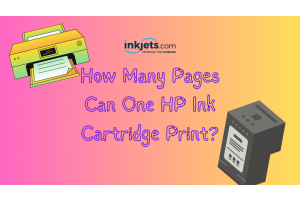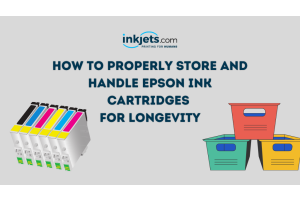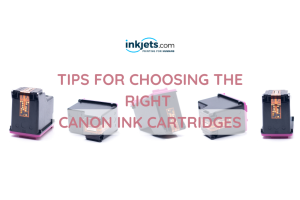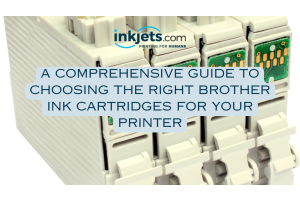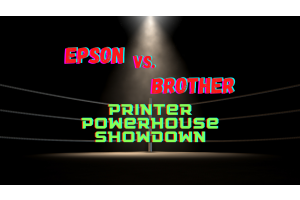
In the realm of printing, whether for personal projects, photographs, or essential documents, the ink you use can significantly influence the outcome. It's not just about clarity or color precision; it's also about how long those prints will hold their ground against time. This brings us to an aspect often overlooked but critical to ensuring the quality and longevity of our prints: the proper storage and handling of ink cartridges.
Epson, a name synonymous with printing excellence, offers cartridges known for their quality and cost-effectiveness. These cartridges are designed to deliver superior print quality while being friendly to your wallet. However, like any high-quality ink, their performance and longevity heavily depend on how they're treated when not in use.
This blog aims to shed light on this underexplored aspect of printing. We're not just talking about tips and tricks; we're diving into practical advice specifically tailored for an Epson inks user. Whether you're a photography enthusiast, a home office warrior, or someone who appreciates the value of a well-printed page, this guide will help you extend the life of your cartridges, ensuring your prints remain vibrant and your printing costs stay down. Let's embark on this journey towards making the most out of our Epson ink cartridges.
Understanding Epson Ink Cartridges

Epson ink cartridges are more than mere containers of ink; they are the lifeblood of your prints, embodying advanced technology that distinguishes them in the world of printing.
At their core, Epson cartridges are designed to deliver a seamless and reliable flow of ink, ensuring each print is as good as the last. This consistency is the result of meticulous engineering, including the use of MicroPiezo technology in many Epson inkjet printers, which precisely controls the droplets of ink ejected onto paper. This technology ensures not just superb print quality but also efficient use of ink, making every drop count.
When it comes to Epson cartridges, users have options, each catering to different needs and budgets:
1. OEM (Original Equipment Manufacturer) Cartridges: These are produced by Epson and are specifically designed for their printers. They guarantee compatibility and optimum performance. Given their premium quality, they require careful handling to maintain their efficacy.
2. Compatible Cartridges: These are manufactured by third-party companies to work in Epson printers. While they offer a cost-effective alternative to OEM cartridges, their performance and compatibility can vary. Users of compatible cartridges should ensure they purchase from reputable suppliers to avoid potential issues with print quality or cartridge recognition.
3. Remanufactured Cartridges: These are recycled OEM cartridges that have been cleaned, refilled, and tested for functionality. They are an environmentally friendly option and can provide good quality prints at a lower price point. However, the process of remanufacturing can affect the longevity of the cartridge, making proper storage and handling even more critical.
Read: Remanufactured vs Compatible: What's The Difference?
Understanding the nuances of each cartridge type is crucial for proper care. Whether you choose OEM, compatible, or remanufactured cartridges, knowing how to handle and store them correctly can significantly impact their performance and longevity.
The Do's and Dont's of Ink Cartridge Storage


The Do's of Ink Cartridge Storage
Proper storage of Epson ink cartridges is not just about finding a spot where they fit; it's about preserving their integrity and ensuring they perform as expected when you finally need them. Here are key practices to keep in mind:
1. Keep in Original Packaging: The importance of this practice cannot be overstated. The original packaging is designed to protect the cartridges from dust, light, and other environmental factors that can lead to drying out or clogging of the nozzles. By keeping the cartridges sealed in their original box, you're not just preserving the ink's quality; you're also safeguarding the intricate parts of the cartridge from damage.
2. Store at Room Temperature: Ink cartridges are best kept in a stable, room temperature environment, typically between 20°C to 25°C (68°F to 77°F). Extreme temperatures can wreak havoc on the ink's consistency, leading to issues like thickening or separation that affect print quality. A stable temperature ensures the ink remains in optimal condition for use.
3. Upright Position: Storing cartridges upright, as recommended by most manufacturers, is crucial for preventing ink from settling or leaking. This position helps maintain even ink flow and pressure within the cartridge, ensuring that it's ready for action whenever you are. Think of it as keeping a bottle of fine wine in the right position to preserve its quality.
4. Avoid Direct Sunlight: Direct exposure to sunlight can degrade the ink quality over time due to UV radiation. This can lead to faded prints or colors that don't match your expectations. Find a cool, dark place for storage, away from windows or areas that receive direct sunlight.
5. Use Within Shelf-Life: Every ink cartridge comes with a "best before" date, and there's a good reason for it. Over time, ink can degrade or the cartridge's components might not function as intended. Using your cartridges within their shelf life ensures you're getting the best possible performance and quality from your prints.
Adhering to these do's of ink cartridge storage is a simple yet effective way to maximize the longevity and quality of your Epson ink cartridges. A little care goes a long way in ensuring your prints come out beautifully, every time.
The Don'ts of Ink Cartridge Storage
While knowing what to do is crucial, understanding what not to do can be equally, if not more, important in preventing premature damage to your Epson ink cartridges:
1. Avoid Extreme Temperatures: Ink cartridges are sensitive to their environment, and extreme temperatures are their nemesis. High heat can cause the ink inside the cartridges to thicken or even evaporate, while freezing conditions can lead to the ink expanding, potentially cracking the cartridge. Both scenarios can result in leaks or degraded print quality. Keep your cartridges away from radiators, air conditioners, and windows to avoid such extremes.
2. Don’t Open Until Needed: There's a temptation to unwrap new gadgets or supplies the moment we get them, but with ink cartridges, patience is a virtue. The packaging protects the ink from air exposure, which can dry it out, leading to clogs or compromised print quality. Wait to open a new cartridge until you're ready to install it in your printer. This small act of restraint can have a significant impact on the cartridge's lifespan and performance.
3. Steer Clear of Humid Areas: Humidity can be as harmful as temperature extremes. Excessive moisture in the air can condense inside the cartridge, affecting the ink's consistency and potentially leading to leakage. This doesn't just mean avoiding obvious places like bathrooms; even basements or kitchens can have higher humidity levels. Store your cartridges in a dry, stable environment to avoid these issues.
4. No Heavy Objects on Top: It might seem convenient to stack supplies on top of one another for storage, but when it comes to ink cartridges, this could spell disaster. Heavy objects can cause physical damage to the cartridges, leading to leaks or, in the worst case, making them unusable. Ensure your cartridges are stored in a manner where they're not under any pressure from above. A dedicated drawer or shelf, where they can lay undisturbed, is ideal.
Read: How to Store Printer Ink Properly
By steering clear of these storage pitfalls, you can significantly extend the life and maintain the quality of your Epson ink cartridges. Remember, how you store them is just as important as how you use them. Keep these don'ts in mind, and you'll be well on your way to achieving consistently high-quality prints without the unnecessary expense or frustration of prematurely damaged cartridges.
The Do's and Don'ts of Ink Cartridge Handling


Proper handling of ink cartridges is just as crucial as their storage. Mishandling can not only lead to immediate issues like leaks or stains but also affect your printer's long-term performance. Here's how to handle your Epson ink cartridges correctly:
The Do's of Ink Cartridge Handling
1. Handle with Care: Always handle ink cartridges gently. Rough handling can damage the cartridge's delicate components, leading to leaks or compromised print quality. When moving cartridges, do so with a steady hand and avoid shaking or dropping them to prevent internal damage.
2. Wear Protective Gloves: Ink stains are notoriously difficult to remove. Wearing gloves while handling cartridges can save you from stubborn stains and also keeps the cartridges clean from oils or residue on your hands. This practice is especially helpful if you're dealing with leaky or remanufactured cartridges.
3. Recycle or Dispose Properly: Ink cartridges are made from materials that can take hundreds of years to decompose in landfills. Many manufacturers, including Epson, offer recycling programs for their cartridges. By recycling or disposing of cartridges properly, you're not only making an environmentally conscious choice but also contributing to the reduction of waste and the conservation of resources.
4. Check Compatibility: Before installing a new cartridge, ensure it's compatible with your printer model. Using the wrong type of cartridge can result in poor print quality, damage to your printer, or even void your printer's warranty. A quick check can save you from these potential headaches.
5. Follow Manufacturer’s Instructions: Whether it's installing, removing, or storing cartridges, adhering to the manufacturer's guidelines ensures you're handling them in a way that maintains both the cartridges' and the printer's integrity. These instructions are designed to optimize performance and minimize risks, so consider them your go-to resource for any cartridge-related queries.
By observing these do's of ink cartridge handling, you're not only safeguarding your cartridges but also ensuring the consistent quality of your prints. Proper handling is a simple yet effective way to extend the life of your cartridges and get the most out of your printing experience.
The Don'ts of Ink Cartridge Handling
While the right practices can enhance the life and performance of your Epson ink cartridges, there are certain actions that can jeopardize their integrity and the quality of your prints. Here are critical mistakes to avoid in ink cartridge handling:
1. Don’t Touch the Chip or Nozzle: The chip and ink nozzle are vital components of your cartridge, responsible for communicating with the printer and delivering ink onto the paper, respectively. Touching these areas can deposit oils and debris from your fingers, leading to contamination or damage. Such interference can result in poor printing quality or cartridge recognition issues. Always handle cartridges by their sides or edges to avoid accidental contact.
2. Avoid Shaking: It might be tempting to shake a cartridge, especially if you're trying to get the last bit of ink out. However, shaking can lead to ink leakage or disrupt the internal ink distribution, causing inconsistent print quality. If you suspect a cartridge is running low, it's better to replace it than to risk shaking and potentially damaging your printer or workspace.
3. Don’t Use Force: Whether inserting a new cartridge or removing an old one, gentle handling is key. Using force can damage not just the cartridge but also the delicate components of your printer. If you're having trouble with installation or removal, double-check to ensure you're following the correct procedure as outlined in the printer's manual. A little patience can prevent a lot of damage.
4. Do Not Refill Unofficially: While refilling ink cartridges can seem like an economical solution, doing so unofficially or using third-party ink can lead to numerous problems, including leaks, degraded print quality, and even printer damage. Furthermore, unofficial refills can void your printer's warranty. If you're interested in refilling, consider official refill kits or services that guarantee compatibility and safety.
5. Avoid Exposing to Air for Too Long: Open cartridges are susceptible to air, which can dry out the ink and lead to clogs within the nozzle. This not only affects print quality but can also render a cartridge unusable. Always reseal cartridges if you're not installing them immediately, and minimize the time they're left exposed during printer maintenance.
By steering clear of these don'ts, you ensure that your ink cartridges—and by extension, your prints—remain in optimal condition. Handling cartridges with care and mindfulness preserves their quality and extends their lifespan, allowing you to enjoy uninterrupted, high-quality printing.
Maintenance Tips for Installed Cartridges


Ensuring your Epson ink cartridges last longer doesn't stop at proper storage and handling. Once installed, regular maintenance is key to maximizing their efficiency and lifespan.
Here are some maintenance tips for keeping your installed cartridges in top condition:
1. Regular Printer Use: It might seem counterintuitive, but using your printer regularly is one of the best ways to prevent ink from drying out. When printers sit idle for too long, ink can start to dry and clog the nozzles, leading to poor print quality and potentially requiring a cartridge replacement sooner than expected. Aim to print a few pages at least once a week to keep the ink flowing smoothly. This can be anything from a test page to a colorful photograph, depending on your ink type.
2. Printer Settings: Familiarizing yourself with your printer's settings can significantly impact ink usage and print quality. For everyday printing, consider setting your printer to "draft" or a similar low-quality setting to save ink. Reserve high-quality settings for important documents or photos. Additionally, adjusting color settings can help conserve color ink; for instance, choose to print in grayscale when color is not necessary. These small adjustments can lead to substantial savings in ink over time.
3. Cleaning Cycles: Most Epson printers offer a cleaning cycle feature, designed to clear blockages and ensure ink flows correctly. While this is a valuable tool for maintaining print quality, it's also worth noting that cleaning cycles consume ink. Use this feature judiciously, only when you notice a decline in print quality that cannot be resolved with regular printing. Also, it's advisable to consult your printer's manual for recommended cleaning cycle frequency to avoid unnecessary ink wastage.
Read: How to Clean a Printer: A Comprehensive Guide
Incorporating these maintenance tips into your routine not only extends the life of your ink cartridges but also ensures that your prints remain high in quality. Regular printer use keeps ink flowing, appropriate settings save ink, and judicious use of cleaning cycles maintains print quality without wasting your valuable ink resources. With these practices, your Epson ink cartridges and printer can provide optimal performance, keeping both your prints and your printer in prime condition.
Summing it up
Navigating the world of printer maintenance and ink cartridge care can seem daunting at first, but with the right practices in place, you can significantly extend the lifespan of your Epson ink cartridges and ensure consistent printing quality. From the initial purchase to regular use, every step you take following the storage, handling, and maintenance tips shared in this blog plays a pivotal role in maximizing the efficiency and longevity of your ink cartridges.
By keeping cartridges in their original packaging until use, storing them at room temperature, and ensuring they are handled with care, you prevent premature drying and damage. Regular printer use, wise printer settings, and judicious use of cleaning cycles further contribute to maintaining optimal print quality while conserving ink. These practices not only save you from unnecessary expenses and frustrations but also contribute to a more sustainable printing environment by reducing waste.
As you put these tips into practice, consider Inkjets.com as your trusted partner in your printing journey. Offering a wide selection of affordable, high-quality Epson ink cartridges, Inkjets.com supports both your cost-saving and environmental sustainability goals. With a commitment to customer satisfaction and a vast inventory of OEM, compatible, and remanufactured cartridges, Inkjets.com is your go-to retailer for all your Epson ink needs.
In conclusion, the longevity and performance of your Epson ink cartridges are largely in your hands. By adhering to the guidelines provided, you can enjoy high-quality prints, save on ink costs, and contribute to a more sustainable printing practice. Let Inkjets.com help you achieve these goals with their reliable, high-quality ink solutions. Happy printing!



